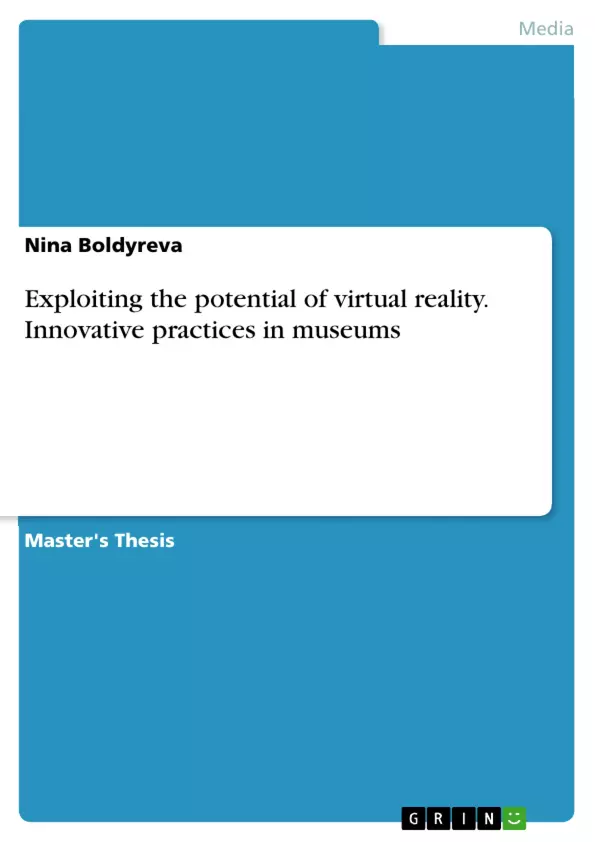This thesis presents a detailed case study analysis of three VR projects ‘Modigliani VR: The Ochre Atelier’ at the Tate Modern, ‘Jupiter Hall’ at the Hermitage Museum, and 'DigiMuse programme’ at the National Museum of Singapore in the context of museological trends and global market. Specifically, it lays the foundation for understanding and analysing the two aspects of this immersive technology: first, how VR applications in museums have fostered the development of partnerships between art and tech worlds which can be understood as a new collaborative ecosystem, and second, how this new type of advanced technological exhibitions can empower to capitalise on these partnership opportunities while achieving museum’s mission. Importantly, this new form of cooperation has an economic component which ensures value creation, in this case, for VR projects, whether in-house, online or in different hosting venues.
The attempt is to integrate the findings to demonstrate how VR technology can become a new channel to achieve museum’s objectives while remaining relevant and sustainable, and suggest a list of important factors to consider for an effective use of VR in museum practice. The present research aims at addressing the gap in the current academic literature by providing an analysis of VR in museum practices, in order to guide future designs of museum VR exhibitions. The thesis provides a solid foundation for further studies of this new collaborative ecosystem between the cultural and technological worlds.
Inhaltsverzeichnis (Table of Contents)
- 1. INTRODUCTION
- 1.1 Background of the study
- 1.2 Thesis statement
- 1.3 Objective of the study
- 1.4. Significance of the study
- 1.5 Literature Review
- 1.6 Methodology
- 1.7 Definition of key terms
- 2. LITERATURE REVIEW
- 2.1 VR Applications in Museums: History Overview
- 2.2 Museological Trends Accelerating VR Technology Adoption
- 2.3 Challenges in the Museum Innovation Process
- 2.4 Strategic Partnerships for Digital Projects in the Art and Cultural Sector
- 3. RESEARCH METHODOLOGY
- 3.1 Institutional Analysis of the Tate Modern, the Hermitage Museum, the National Museum of Singapore
- 3.2 VR Exhibitions Production
- 3.3 System Thinking Framework
- 3.4 Field Study
- 3.5 Limitations of the Study
- 4. DISCUSSION OF FINDINGS
- 4.1 The Tate Modern
- 4.1.1 Institutional Analysis
- 4.1.2 The Modigliani VR: The Ochre Atelier
- 4.1.3 Conclusion
- 4.2. The Hermitage Museum
- 4.2.1. Institutional Analysis
- 4.2.2 The Virtual Jupiter Hall
- 4.2.3 Conclusion
- 4.3 The National Museum of Singapore
- 4.3.1 Institutional Analysis
- 4.3.2 The DigiMuse Programme
- 4.3.3 Conclusion
- 5. CONCLUSION AND RECOMMENDATIONS
- 5.1 Conclusions
- 5.1.1 In-house Value of VR Exhibitions
- 5.1.2 Online Value of VR Exhibitions
- 5.1.3 Outreach Value of VR Exhibitions
- 5.2 Recommendations
Zielsetzung und Themenschwerpunkte (Objectives and Key Themes)
This thesis explores the potential of virtual reality (VR) technology in museums, focusing on its impact on museum practices and its potential to foster innovative partnerships between the art and technology sectors. The study aims to analyze the implementation of VR exhibitions in three prominent museums: the Tate Modern, the Hermitage Museum, and the National Museum of Singapore. The research aims to bridge the gap in academic literature by examining how VR can contribute to achieving museum objectives and foster sustainability in the digital age.
- The adoption of VR technology in museums and its impact on traditional practices.
- The development of partnerships between museums and technology companies in the VR space.
- The economic value of VR exhibitions, both within museums and for online audiences.
- The potential of VR to expand the reach of museum content and engage new audiences.
- The challenges and opportunities associated with incorporating VR into the museum setting.
Zusammenfassung der Kapitel (Chapter Summaries)
Chapter 1 introduces the study, providing a background and context for the research on VR applications in museums. It outlines the thesis statement, objectives, significance, and methodology. The chapter also defines key terms and presents a literature review of existing research on VR in the museum sector. Chapter 2 delves deeper into the existing body of literature on VR in museums. This chapter explores the history of VR applications in museums, analyzes the museological trends driving VR adoption, and examines the challenges associated with integrating VR into museum operations. It concludes with a discussion of strategic partnerships in the art and cultural sector for digital projects. Chapter 3 outlines the research methodology employed in the study. This includes a detailed description of the institutional analysis of the three case study museums, a discussion of VR exhibitions production, and an explanation of the System Thinking Framework used to analyze the data. The chapter also covers the field study methodology and identifies the limitations of the study. Chapter 4 presents a discussion of the findings from the case studies of the Tate Modern, the Hermitage Museum, and the National Museum of Singapore. The chapter analyzes the institutional context of each museum and explores the specific VR exhibitions developed by each institution. It offers insights into the successes and challenges of each project and provides a critical analysis of the implementation of VR in each museum setting. Chapter 5 concludes the thesis, drawing together the key findings from the research. It presents a comprehensive analysis of the in-house, online, and outreach value of VR exhibitions in museums. This chapter also offers recommendations for the future of VR technology in museums, drawing upon the insights gleaned from the case studies and the broader literature review.
Schlüsselwörter (Keywords)
This thesis explores the intersection of VR technology and the museum sector, focusing on the development of immersive experiences. Key terms and concepts include VR applications in museums, museological trends, challenges in museum innovation, strategic partnerships, institutional analysis, VR exhibitions production, System Thinking Framework, and the economic value of VR projects.
- Quote paper
- Nina Boldyreva (Author), 2018, Exploiting the potential of virtual reality. Innovative practices in museums, Munich, GRIN Verlag, https://www.grin.com/document/425399



